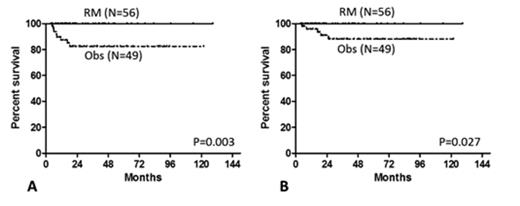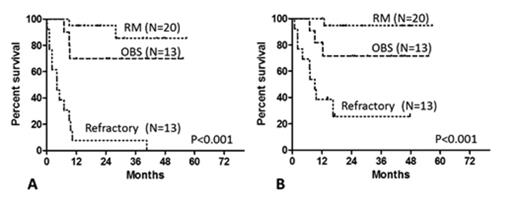Abstract
Introduction: Diffuse large B-cell lymphoma (DLBCL) is a heterogeneous group of aggressive lymphomas with a relapse/refractory rate of 30-40% under the current standard Rituximab plus cyclophophamide, adrimycin, vincristine and prednisone (R-CHOP21) treatment. As mechanism of action, Rituximab can target the B-cell receptor (BCR) and NF-ĸB signaling pathways, of which activating gene mutations are most frequently identified in activated B-cell-like (ABC) subtype of DLBCL and associated with increased disease relapse of the patients. The aim of our study was to investigate the clinical efficacy of additional two cycles of Rituximab maintenance (RM) in DLBCL and its relation with mutational status involved in BCR/NF-ĸB cascade.
Methods: We retrospectively analyzed a total of 534 de novo DLBCL patients after 6 cycles of R-CHOP21 regimen in our institution from December 1998 to December 2012. Among 413 patients achieved complete response (CR), 211 patients received additional 2 cycles of RM in a intent-to-treat manner and 202 patients underwent observation (OBS). The remaining 121 patients were primarly refractory to R-CHOP regimen. All the patients were classified according to IPI and NCCN-IPI as previously described. Immunohistochemistry for germinal center B-cell (GCB) or non-GCB subgroups were determined by Hans classification. The mutational status of BCR/NF-ĸB-associated genes (mainly as CD79A, CD79B, MYD88, and CARD11) were detected in tumor samples of 124 patients (48 cases, 43 cases and 33 cases in the RM, OBS and Refractory group, respectively).
Results: No significant difference of clincial and biological characteristics were found between the RM and OBS group, including age, gender, Ann Arbor stage, ECOG score, number of extranodal involvements, serum lactic dehydrogenase level, B symptoms, IPI and NCCN-IPI risk group, and GCB/non-GCB ratio. With a median follow-up of 36.5 months, the 3-year progrssion free survival (PFS) was 79.9% and 73.6% (P=0.123), and the 3-year overall survival (OS) was 91.0% and 87.4% (P=0.149) in RM and OBS group, respectively. According to NCCN-IPI, remarkable improvement of 3-year PFS and OS was observed in low-risk patients of the RM group (100% and 100%), comparing with those of the OBS group (82.5% and 88.2%, P=0.003 and 0.027 respectively, Figure 1). Similarly, male patients with low-risk IPI could also benefit from additional 2 cycles of Rituximab with a 3-year PFS of 100% in RM vs 84.4% in OBS (P=0.006).
Overall, BCR/NF-ĸB mutations were detected in 46/124 patients (37.1%), including 20/48 (41.7%), 13/43(30.2%) and 13/33 (39.4%) patients in RM, OBS and Refractory group, respectively. However, MYD88 mutations were more frequently observed in the Refractory group than in the RM/OBS group (18/33 vs 6/91, P<0.001, Table 1). Mutations are not prognostic indicators for PFS or OS in general, but interestingly, those mutation-bearing patients showed a tendency of improved disease prognosis in the RM group compared with that of the OBS group (3-year PFS 85.5% vs 70.0%, P=0.091, 3-year OS 94.7% vs 71.6%, P=0.059, Figure 2).
Conclusion: Low-risk NCCI-IPI patients with DLBCL responded to R-CHOP regimen benefit from additional two cycles of RM. As a potential target of Rituximab, BCR/NF-ĸB-associated mutations reflected disease resistance to Rituximab. Whether prolonged administration of Rituximab could improve the prognosis of the patients with these mutations warrants further investigation.
The distribution of BCR/NF-κB-associated mutations in patients with DLBCL
| Mutated gene . | Refractory (N=33) . | CR (N=91) . | ||
|---|---|---|---|---|
| Additional 2R (N=48) . | Observation (N=43) . | P value . | ||
| CD79a | 1 (3.0%) | 0 (0%) | 0 (0%) | 0.595a |
| CD79b | 5 (15.1%) | 10 (20.8%) | 6 (13.9%) | 0.750 a |
| MYD88 | 18 (54.5%) | 3 (6.0%) | 3 (6.9%) | <0.001b |
| CARD11 | 1 (3.0%) | 7 (14.0%) | 4 (9.3%) | 0.244a |
| Mutated gene . | Refractory (N=33) . | CR (N=91) . | ||
|---|---|---|---|---|
| Additional 2R (N=48) . | Observation (N=43) . | P value . | ||
| CD79a | 1 (3.0%) | 0 (0%) | 0 (0%) | 0.595a |
| CD79b | 5 (15.1%) | 10 (20.8%) | 6 (13.9%) | 0.750 a |
| MYD88 | 18 (54.5%) | 3 (6.0%) | 3 (6.9%) | <0.001b |
| CARD11 | 1 (3.0%) | 7 (14.0%) | 4 (9.3%) | 0.244a |
a: No significantly difference was found between Refractory group and CR group.
b: Significantly difference was found between Refractory group and CR group (p<0.05).
Progression-free survival (A) and overall survival (B) curves of diffuse large B-cell lymphoma patients according to low-risk NCCN-IPI.
Progression-free survival (A) and overall survival (B) curves of diffuse large B-cell lymphoma patients according to low-risk NCCN-IPI.
Progression-free survival (A) and overall survival (B) curves of diffuse large B-cell lymphoma patients with BCR/NF-ĸB-associated mutations.
Progression-free survival (A) and overall survival (B) curves of diffuse large B-cell lymphoma patients with BCR/NF-ĸB-associated mutations.
No relevant conflicts of interest to declare.
Author notes
Asterisk with author names denotes non-ASH members.



